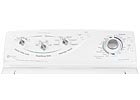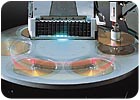
Washing machine control panel with UV coating. Photo courtesy of Maytag
Knowing about different decorating and coating technologies can make a better design engineer, one whose product dreams become reality. Ultraviolet (UV) curing technology has been around for over 30 years, but remains an unknown to many designers even though it is commonly used in a wide variety of industrial processes for curing adhesives, inks and coatings. In fact, many of the things used in everyday life have been UV cured. For example, most cell phone keypads have UV cured inks, and compact discs have UV cured printing and protective clear coatings.
The Process
UV curing is a chemical process in which a liquid ink or coating solidifies upon exposure to UV energy. Most traditional inks or coatings require a thermal oven, which uses heat to drive off solvents or water, thus solidifying the coating. Instead of using a heat-activated catalyst, UV inks and coatings contain photoinitiators, which are sensitive to specific wavelengths of UV energy to start the solidification process. Most UV curing processes are very fast, curing the ink or coating in a matter of seconds. As a result, production speeds increase dramatically. Often manufacturing processes that are currently batch or off-line can convert to a continuous or indexing production process. UV inks and coatings contain very little or no volatile organic compounds, eliminating the need for incinerators or other remediation. In addition, UV coatings typically have superior chemical and scratch resistance.Typically the application of UV inks and coatings to a part is similar and familiar. For example, UV inks are often screen-printed, pad printed, offset, flexographic or ink jet. Likewise, UV coatings can be sprayed, flow coated, dip coated, curtain coated or vacuum coated. Because UV coatings tend to be high solids, even 100 percent solids, formulators have to work hard to create suitable viscosities for the desired application method.

UV curable coating on a fax machine. Photo courtesy of HP.
Appliance Applications
UV curing is already used in the production of many appliances, from the inside out. For example, many of the electronic components in appliances have UV cured adhesives, conformal coatings and markings. Touch pads have UV-printed graphic overlays. Probably the biggest application relates to UV inks and coatings on appliance control panels, displays and nameplates. For example, UV inks are printed onto the control panels (metal or plastic) of clothes washers and dryers and onto the keys of computer keyboards and fax machines. There are several reasons why UV inks are the best solution for this type of application. First and foremost, UV inks on control panels and keys are very durable, and more scratch and chemical resistant. So the appliance will remain looking newer longer. Then of course there are the manufacturing benefits mentioned earlier such as higher production rates, reduced scrap and reduced work-in-process. UV inks are also screen printed onto vending machine backlit panels to produce vivid, eye-catching color graphics.Clear hard coats on plastic substrates are another common UV curing application for appliances. As more appliances incorporate digital controls, most need a durable, optically clear interface window. In addition, plastics are making inroads into the appliance market due to their lightweight, molded-in color and ease of forming. However, coatings are sometimes needed to improve the feel (soft touch is popular now) or durability of the surface, or protect printed or applied graphics. UV clear coats easily meet these requirements on a variety of plastics such as polycarbonate, acrylic and acrylonitrile butadiene styrene (ABS).

Compact discs get UV cured printing followed by a protective clear coating.
Exterior Applications
Of course exterior applications always pose a challenge to inks and coatings because exposure to the elements causes chalking, cracking and peeling. Exterior coatings require UV stabilizers in them to protect from the damaging UV rays of the sun. Traditional UV stablizers pose a problem for UV coatings because they interfere with the UV energy needed to cure the coatings. However, new UV stabilizers and photoinitiators have been developed that enable many exterior applications of UV coatings, like lawn and garden equipment, that have a UV cured clear coat to provide scratch and chemical resistance, and weatherability.Design Implications
The possibilities are endless with UV curing. UV curing can change production rates enough to allow the incorporation of that control panel that will win over the market. Or maybe there's a heat sensitive material that's worth incorporating, but it couldn't withstand the plant paint line oven temperatures. Since UV curing is a "cool" process, that heat sensitive material may now be an option. Plus, that new product can look great with a UV coated or decorated surface without generating any VOCs.In addition to being an energy efficient, environmentally friendly, high-speed, high-quality process, UV curing is often an enabling technology. Probably the most often sited example of this is the manufacture of fiber optics. UV coatings protect the fiber strands and enable highspeed fiber optic manufacturing to become a reality. UV curing can "enable" the design engineer's next design effort.
For information on reprints of this article, contact Jill DeVries at devriesj@bnpmedia.com.

Report Abusive Comment